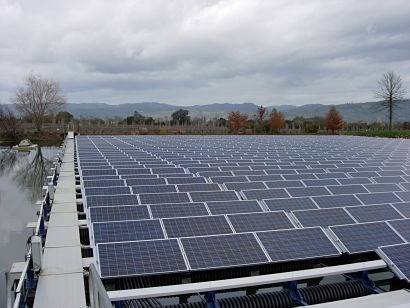
The potential global capacity for deploying floating solar photovoltaic (FPV) power is currently around 4 terawatts (TW). While large scale ground-mounted photovoltaic development may be more challenging due to difficult terrain or land scarcity, many water bodies remain largely available for power generation – making the business case for FPV extremely attractive. After a slow start, the FPV market had grown to 2 GW global installed capacity in 2020. DNV foresees a total of 7-11 GW to be installed by 2025 with a major increase from 2023 onwards.
However, standards applicable to FPV are still largely lacking, potentially leading to project delays and obstacles in permitting and authorisation, which can be an issue for the utility-scale renewables industry. FPV players are at best relying on inconsistent and diverse procedures and adjacent codes adopted from other sectors, which may hinder the industry’s capacity to rapidly scale up.
In order to provide comprehensive guidance to FPV operators, DNV has spearheaded a JIP involving 24 of the sector’s leaders to develop the world’s first recommended practice (RP) on the design, development, and operation of FPV systems. DNV-RP-0584 was successfully introduced in 2021 as the first step on the path towards FPV standards and certification.
Following this breakthrough, DNV has strived to collaborate with industry players to move from recommended practices to FPV-specific reference standards. This has enabled them and their stakeholders to manage risk and complexity with confidence, supporting the shift to renewable and low-emission energy sources.
DNV has taken the lead on two new JIPs to achieve this. The first is to share and improve the best practices for the design of FPV-specific anchoring and mooring structures. Based on a selection of floating solar concepts, the project – which gathers stakeholders from all areas of the FPV field –, will address a variety of challenges expected when deploying installations in larger islands with shallow drafts. The second JIP proposes to draw from DNV’s expertise and network to create an adequate unified FPV-specific floats design, testing and qualification standard that will introduce clearer, faster and cheaper performance-based procedures that are layout-neutral and failure-mode-specific.
“The use of industry standards will ultimately lead to higher quality, lower failure rates and more adequate access to data-driven digital solutions and assurance services like verification and certification” said Juan Carlos Arévalo, executive vice president at GPM&S, a DNV company. “This can only be achieved through joint efforts and continuous knowledge sharing. This will not lead to the convergence of floating solar photovoltaic technology into a dominant concept, but rather establish a common approach to analysis and simulation that allows players to consistently improve on one another’s best practices and lay out industry-wide testing and quality assurance procedures.”
Dana Olson, global segment lead for solar power, Energy Systems at DNV, added that FPV structures present unique challenges to the solar industry due to specific hydrodynamic loads, risks of corrosion and specific components, such as floats, anchors and mooring lines and that several large customers in the solar community have requested development of new, tailored standards to guide them in the development of resilient FPV projects.
“In particular, our input on the determination of design environmental loading will provide crucial guidance to the whole field, and we’re eager to engage directly with customers across the industry at this crucial step of FPV project development” said Mr Olson.
For additional information:

